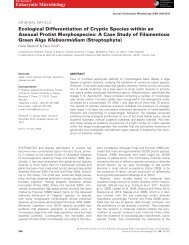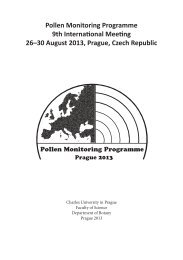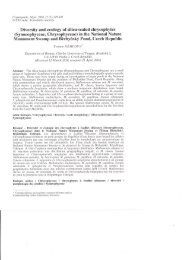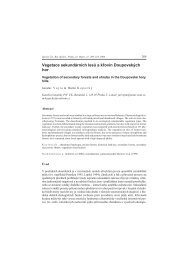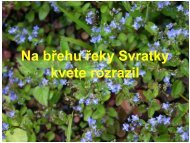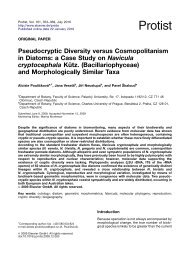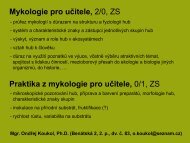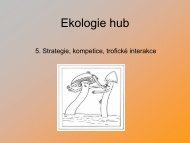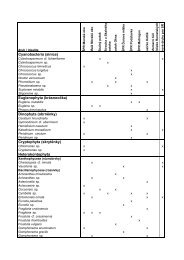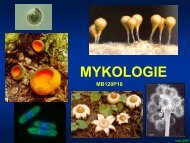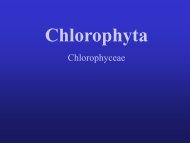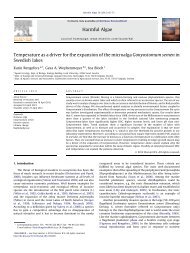Trebouxiophyceae, Chlorophyta - (S)FTP hesla na Botany
Trebouxiophyceae, Chlorophyta - (S)FTP hesla na Botany
Trebouxiophyceae, Chlorophyta - (S)FTP hesla na Botany
You also want an ePaper? Increase the reach of your titles
YUMPU automatically turns print PDFs into web optimized ePapers that Google loves.
2 Aims of the thesis<br />
Aims and outline of the thesis<br />
The general objective of the thesis was to taxonomically revise several genera of the<br />
green aerophytic algae, using both traditio<strong>na</strong>l morphological and modern molecular phylogenetic<br />
approaches. For the revision, I chose two coccal genera characterized by the complicated<br />
chloroplast structure (Asterochloris and Dictyochloropsis) and the ubiquitous filamentous<br />
genus Klebsormidium.<br />
In particular, two principal aims can be summarized as follows:<br />
1) To test the stability and suitability of current and newly suggested morphological<br />
discrimi<strong>na</strong>ting features for the distinction of the particular species<br />
(Papers 1, 2, 4).<br />
2) To revise the species concept of the genera, using the combi<strong>na</strong>tion of selected<br />
morphological features and molecular markers (Papers 3, 5).<br />
3 Outline of the thesis<br />
The thesis comprehends the taxonomical investigation of three aerophytic green algal<br />
genera – Klebsormidium, Asterochloris and Dictyochloropsis. In Klebsormidium, the species<br />
concept differentiating in morphological view two closely related species was investigated by<br />
the comparison of several morphological characters in 40 isolates. In Asterochloris and Dictyochloropsis,<br />
the combi<strong>na</strong>tion of detailed morphological study of chloroplast structure and<br />
the molecular phylogenetic a<strong>na</strong>lyses was performed to delimit particular species of the genera.<br />
3.1 Species concept in Klebsormidium<br />
The stability and suitability of several morphological characters was tested for the distinction<br />
between two <strong>na</strong>rrowly related species Klebsormidium flaccidum and K. nitens. In<br />
forty isolated strains, the variability in cell dimensions, filament length, character of zoosporangia<br />
and zoospore germi<strong>na</strong>tion was studied. Moreover, the habit of cell morphology in relation<br />
to the culture age was studied in six randomly chosen strains. In two selected strains, the<br />
effect of physico-chemical parameters (temperature, humidity, illumi<strong>na</strong>tion and pH) on cell<br />
width was further studied. The study showed variability in taxonomically relevant morphological<br />
features during growing of the species in cultures and impossibility to clearly define<br />
the species by the combi<strong>na</strong>tion of current morphological markers (Paper 1).<br />
The comparison of ascertained morphological features with the molecular phylogenetic<br />
data was not performed, since the broad phylogenetic study of Klebsormidium is presently in<br />
progress, based on the comparison of rbcL sequences of forty isolated strains (Fabio Rindi,<br />
pers. comm.).<br />
3.2 Taxonomy of Asterochloris<br />
First, the confocal microscopy was utilized to compare the chloroplast morphology and<br />
ontogeny among five strains of the green alga Asterochloris. The exami<strong>na</strong>tion revealed the<br />
existence of interspecific differences in the chloroplast ontogeny of Asterochloris, based upon<br />
the specific chloroplast structures observed in a single species (Paper 2).<br />
Next, the broad phylogenetic study was performed on the 34 cultured strains, using nuclear-encoded<br />
ITS rDNA and actin intron sequences as the phylogenetic markers. The combi<strong>na</strong>tion<br />
of molecular phylogenetic a<strong>na</strong>lyses and morphological exami<strong>na</strong>tion resulted in the revision<br />
of the genus. 13 species were newly delimited, including the description of 7 species<br />
8



